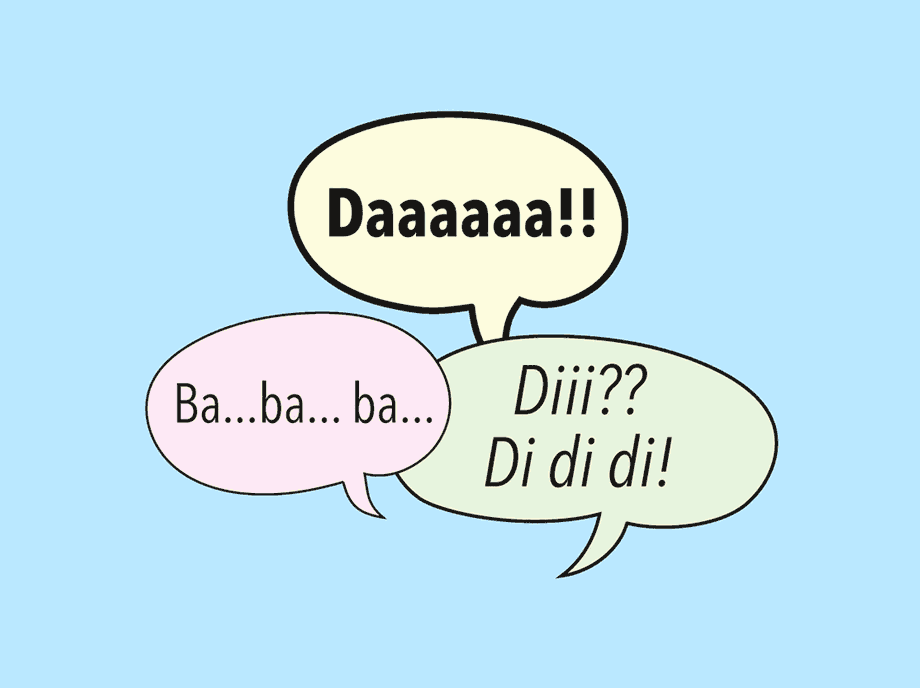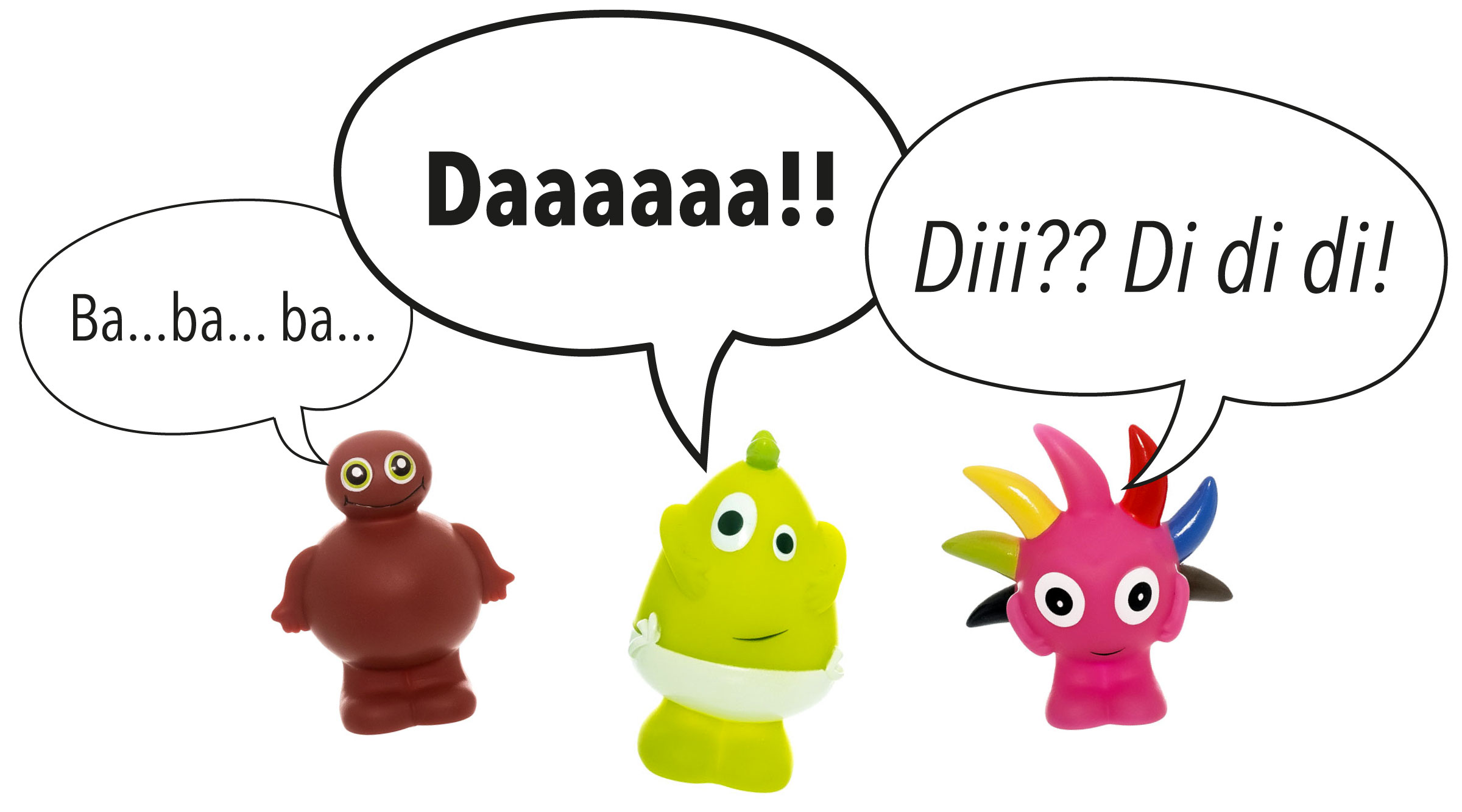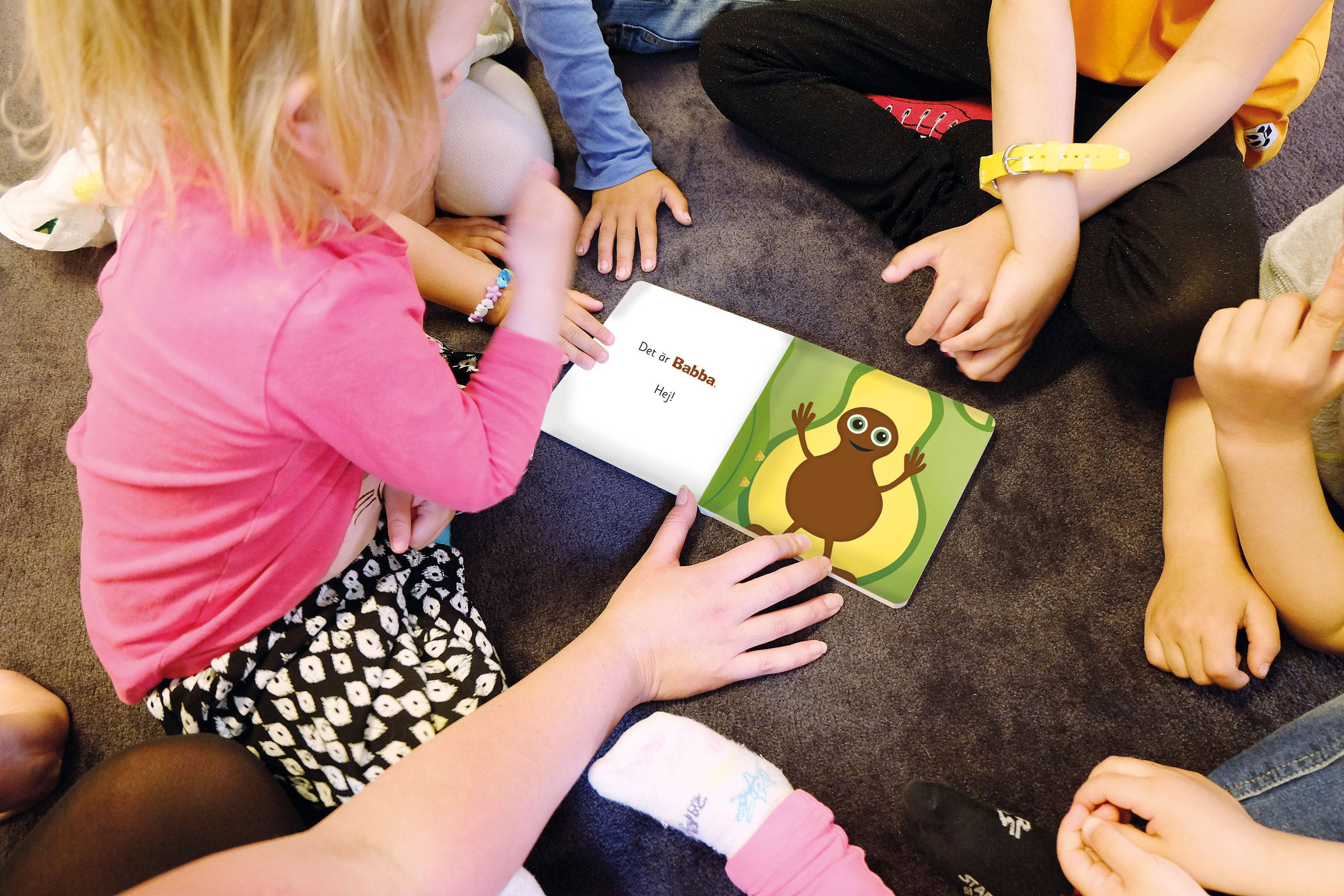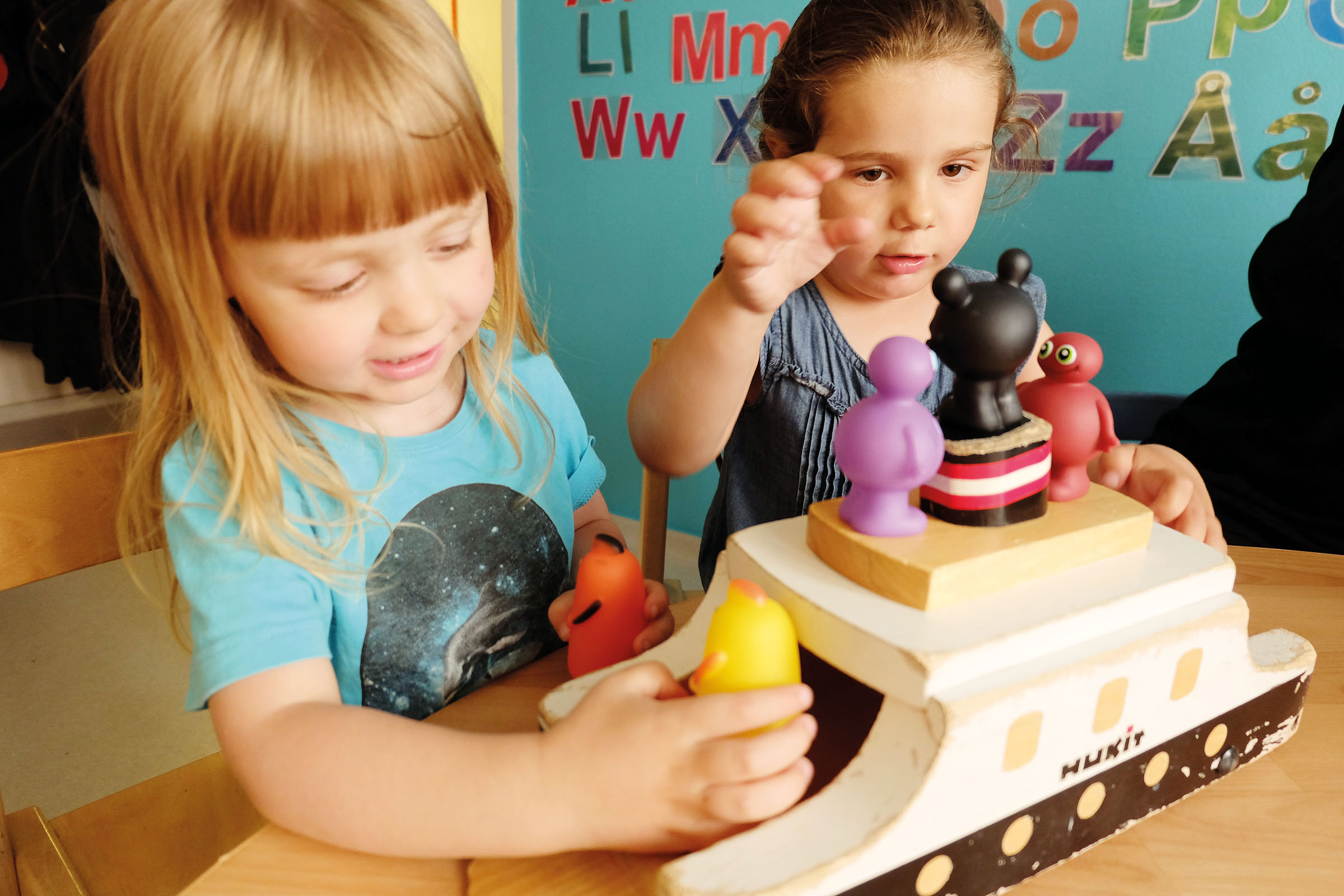Language play with Babblarna
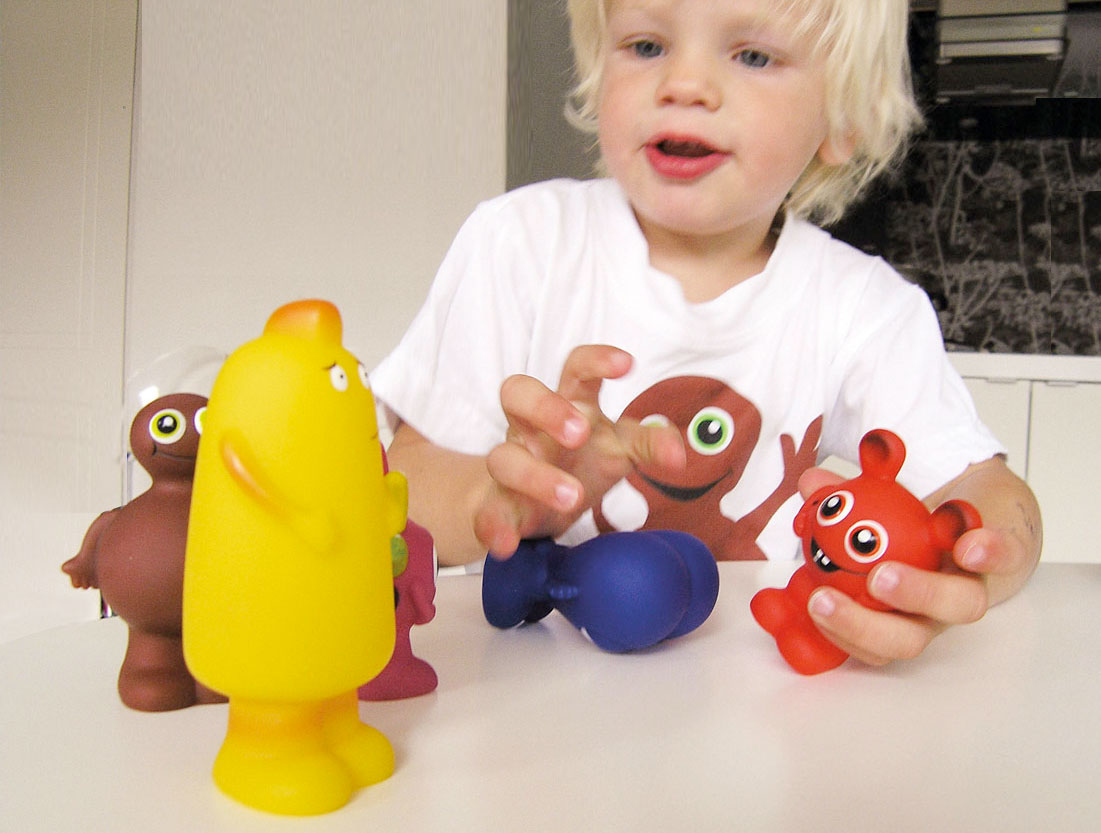
Language play with Babblarna
The Babblarna are more than just a group of colorful characters. Here we have gathered some tips on how they can be used to play and develop speech and language:
Talk about and like the Babblarna!
The fact that the Babblarna have their particular names is no coincidence. Their names are composed of language sounds that appear early in children’s speech and they are therefore often easy for children to start saying. The Babblarna themselves speak with the sounds in their names, so Diddi speaks “di diddi diii” and Babba “baaa babab ba”. By playing and sounding like the Babblarna and encouraging imitation, the child can get started and get a taste of speech even before the real words come.
Practice listening
A good first step in playing with the characters is to train the ear to hear the small differences between the language sounds in the names. With the characters, the child learns to hear the difference between the language sounds ba-da, bi-di, bo-do and ba-bi-bo or da-di-do. Play with the characters and ask your child to give you, for example, Bibbi. Remember not to start with all the characters at once, start with only two characters and as the child becomes confident, add another character and so on. Make the game fun and exciting and let the characters hide and play peekaboo.
Act happy, act sad
If the child has learned to say one or several of the characters’ names, you can start playing fun role-playing games where the child has one character and you another. The child says ba-ba-ba-ba and you respond with your character sounding as if you are really talking, but only use the character’s sound – di-di-di-di-di. Pretend as if you are asking questions, becoming happy, becoming sad, and so on – but only do it with your character’s language sounds, not words. Let the difference be clear in how you sound when you speak happily, sadly, loudly, quietly, and so on. Your child is then enticed to try to speak with Swedish intonation and stress patterns, without knowing any words – it’s excellent preparation for later speaking with words.
Read the books and put words on everything!
Reading children’s books is always stimulating for language, but Babblarna’s books come with an extra language-stimulating twist. They have a thought-out structure with clear repetition throughout the book, giving children a distinct space to guess, fill in, and be an active part of the reading. Babblarna’s books are not just something one reads, but rather something one does together with the child. The basic idea in all Babblarna’s books is that the child should be as active as possible and fill in words or answer questions in their own way and at their own pace.
Again and again
A good way to think about book reading and games is that what is familiar to the child, and what they already know, is the most fun. Most children love to read the same book over and over again and that’s great! In repetition, children reinforce their linguistic knowledge. When the child knows the book or game almost by heart, it’s a good idea to start adding something small and new at each reading.
Structure
It’s no coincidence that Babblarna’s books are clearly structured and always set up in the same way.
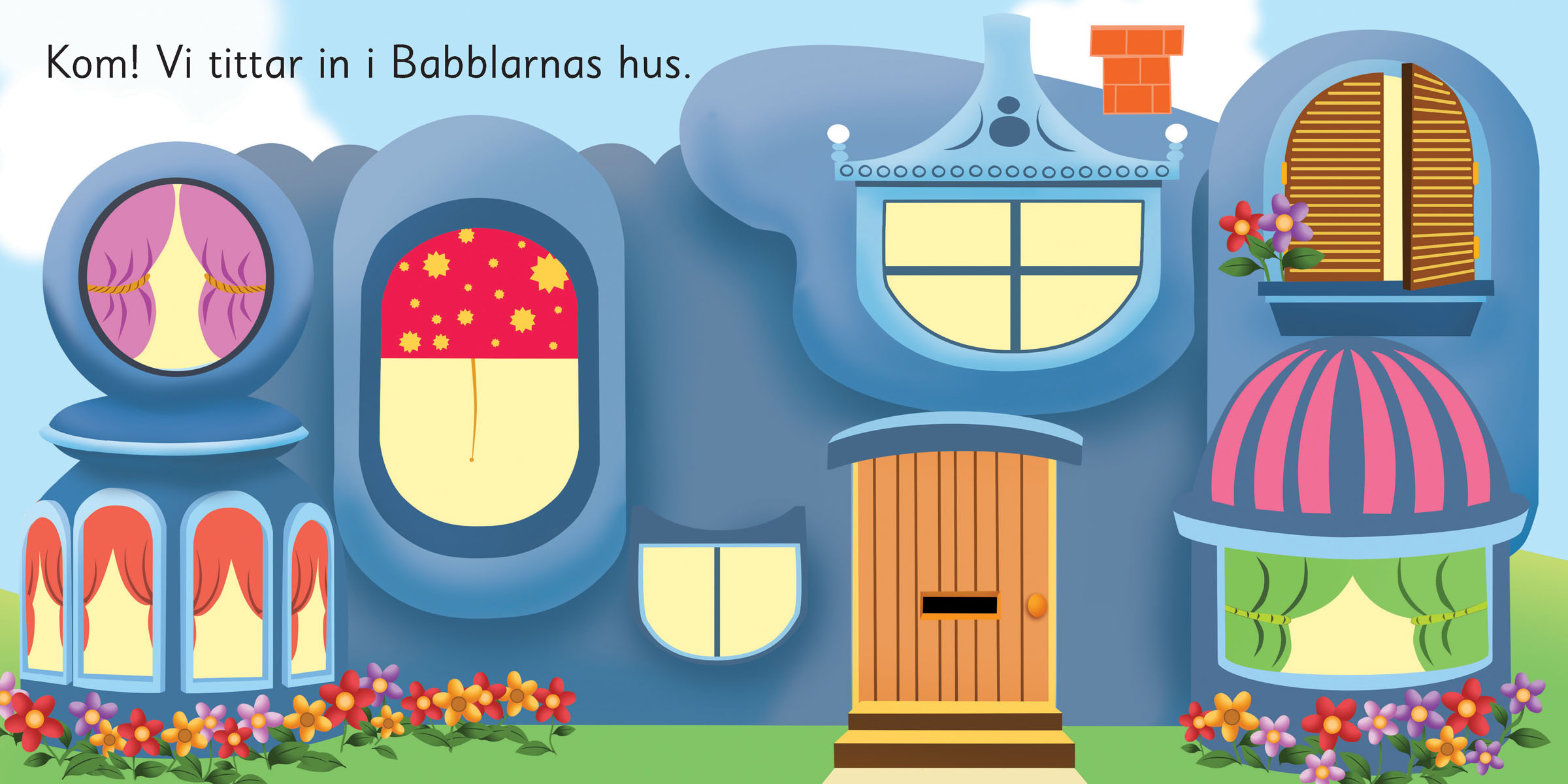
First, in most of Babblarna’s books, there is a spread that acts as an introduction to what the book will be about. When the child already knows the content of the book, it’s fun for the child to already on this first spread tell what is going to happen! It’s good memory training and practice in telling oneself.
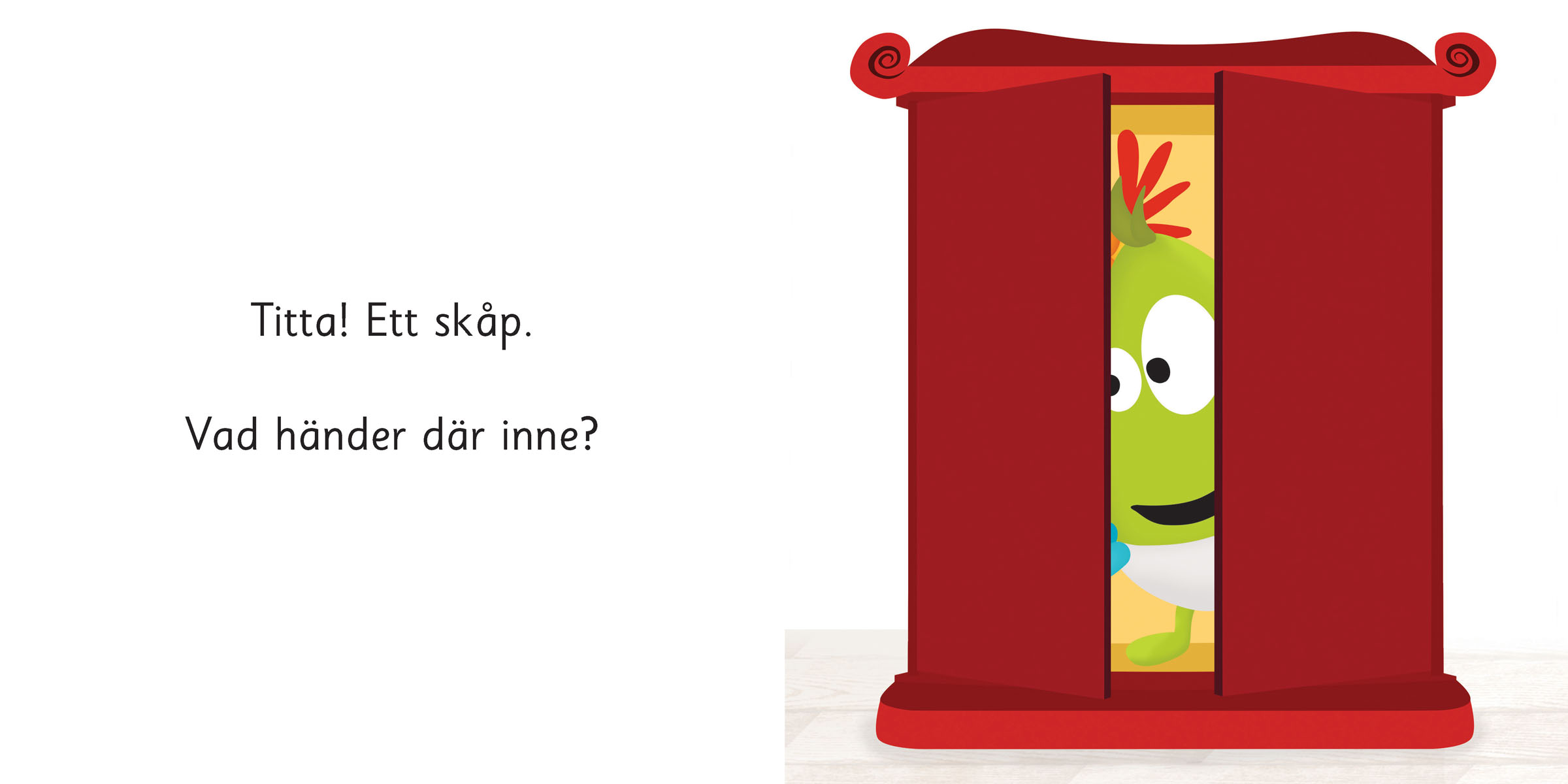
Then follow the spreads with questions that you ask and which give a clear space for the child to answer, guess or fill in. Let the child take their place and give plenty of time to play their role. In the beginning, you can happily help the child to answer together with you, soon the child wants to answer themselves.
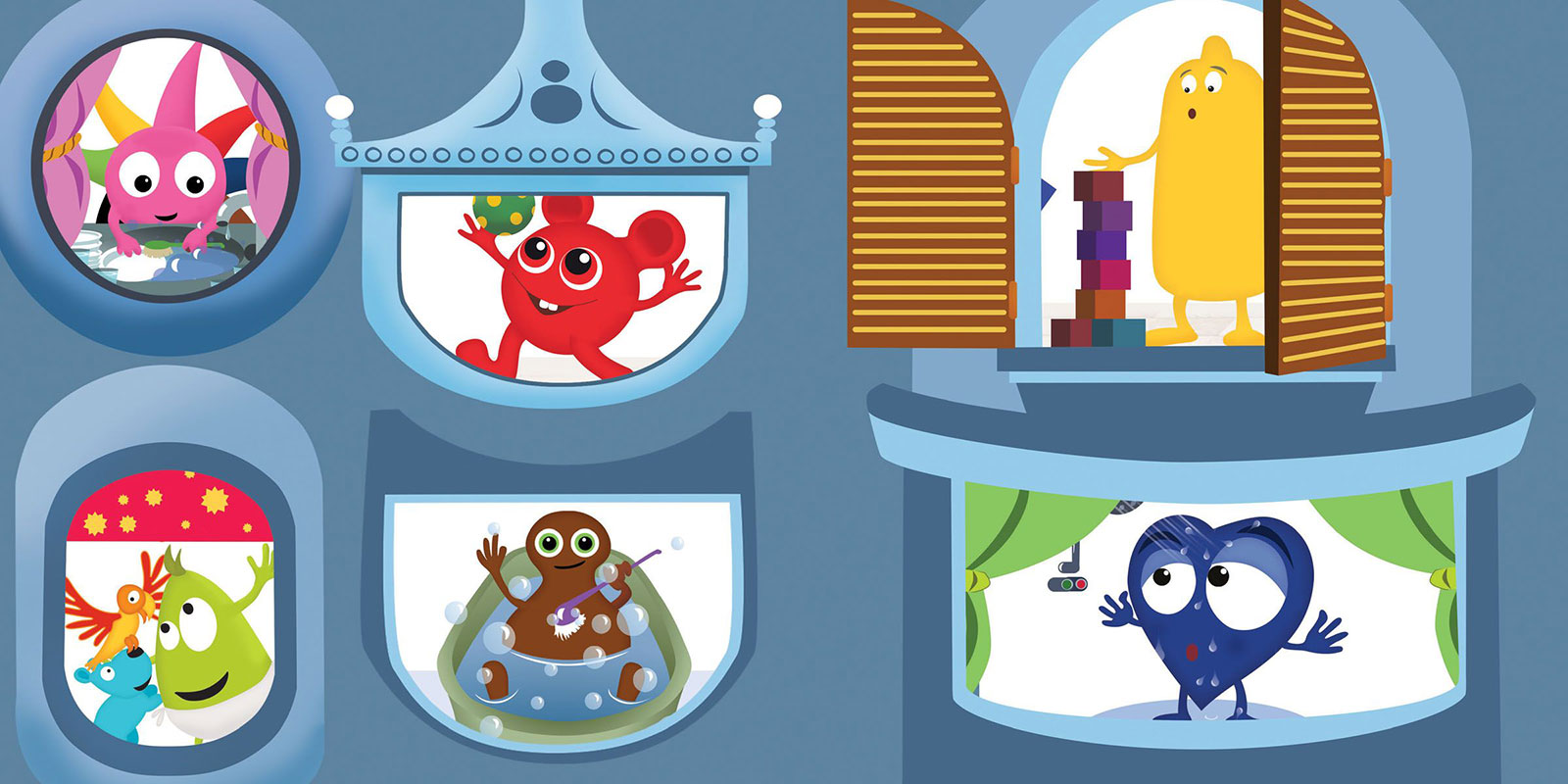
Last in most of the books, there is a spread that summarizes what the book was about. Here the child can tell what the different characters did or chose. Take plenty of time on this spread and wait for the child’s own story, just help as much as needed for the child to be able to tell themselves.
See the books as something you do together, take turns telling. The child has their place and you have yours – just like it works when you talk to each other. Don’t forget – the most important thing is that you have fun!
Different types of books

In “Dadda Visits,” there are doors to knock on, which is especially suitable for those children who need to be motorically active to maintain concentration. And with “Where are Babba’s things?” it’s easy to work with tricky concepts like location words (under, on, behind).
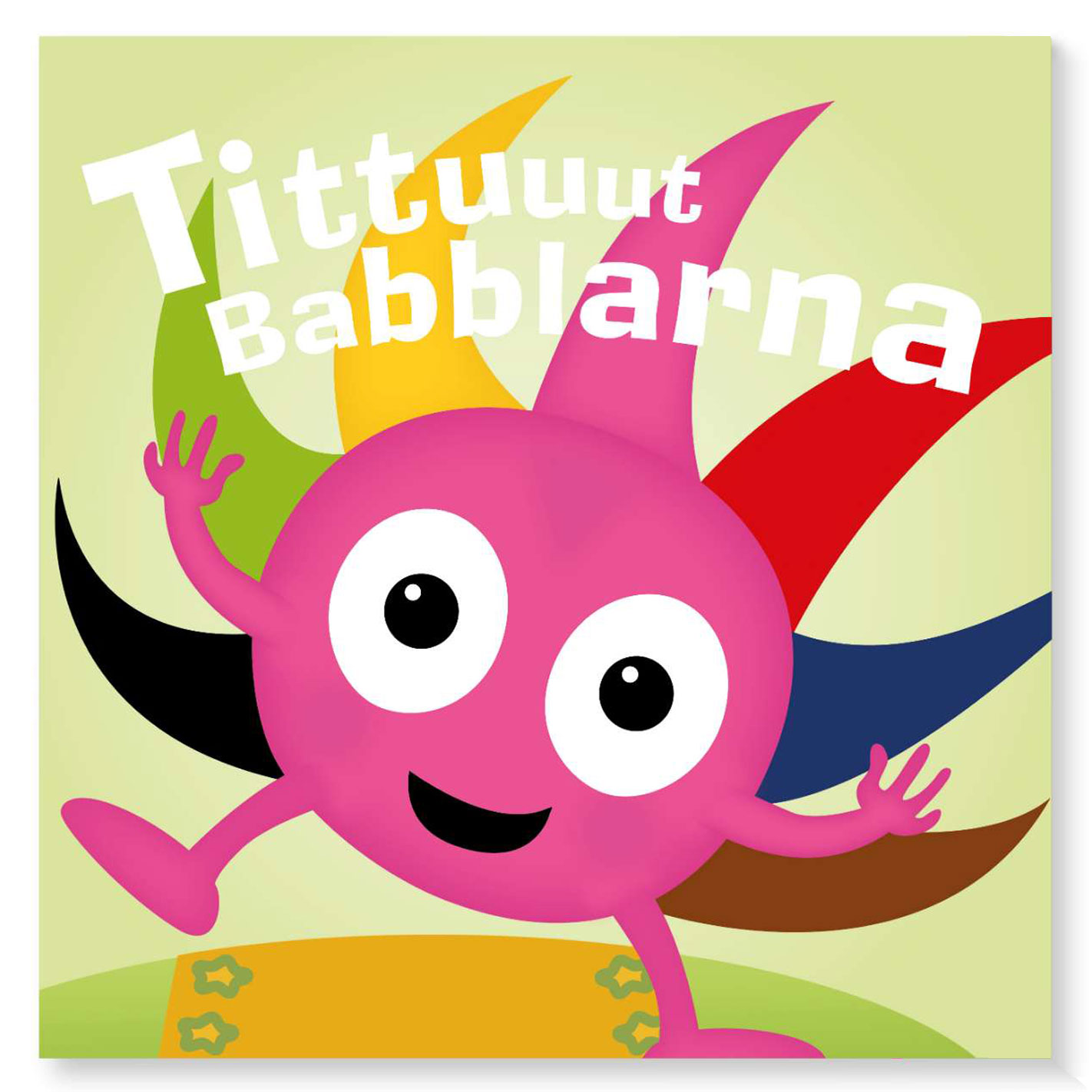
The “chat books” in cardboard are almost textless to entice both you and your child to talk about everything happening in the pictures. Empty out all the content in the pictures, talk a lot, make up your own story. A good tip is to stick to approximately the “same story” each time and just add a little something new now and then. Most children love the repetition and it’s only when they “know” the story that they truly become active themselves in the book reading by pointing and telling. (Examples of chat books are: Tittuuut Babblarna, Babbibboo Babblarna!, Daddiddoo Babblarna?)
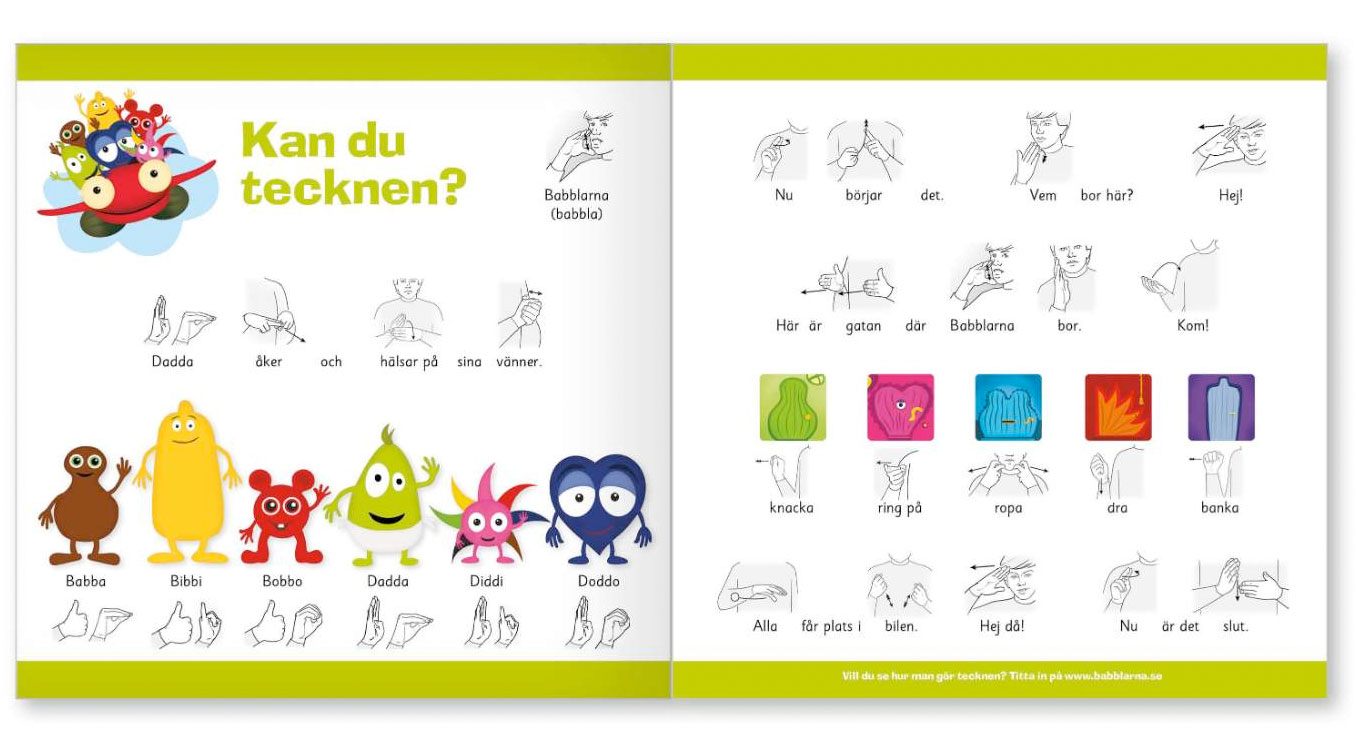
At the back of most books, there are also illustrations showing how to sign the different words of the book, as signs combined with speech are an excellent way to stimulate early language development. Signs are a great help for many children to clarify words and make it easier to learn them. For many children, the signs are a bridge to speech that allows speech and language to develop better. Signing is fun for all children and adults – give it a try!
Play, play, play!
With Babblarna, you can play anything and simultaneously build language. You can be inspired by the books or think of other things that the children find fun
. Use Babblarna along with other toys you already have and let the children participate and decide! If we put words on what is happening in the play, capture what the children are saying and expand on it, it can be very language developing.
Affirm what the child is saying
If your child says “Babba nanna,” you can say “Yes, Babba is going nanna. Babba is going to sleep.”
We can also make suggestions about what could happen in the play and see if the children can respond with words, gestures or signs:
“Should Bibbi bathe or build with blocks?” and “Who else wants to join? Dadda or Babba?”
It is only our (and the children’s) imagination that sets the limits!
Extra support in language development
For small and big children who need extra support in their language development, you can also work purposefully and structuredly with Babblarna. At Hatten Publishing, there are both factual books, guides, and a lot of different language playful material for that.
About Språkbyggarna
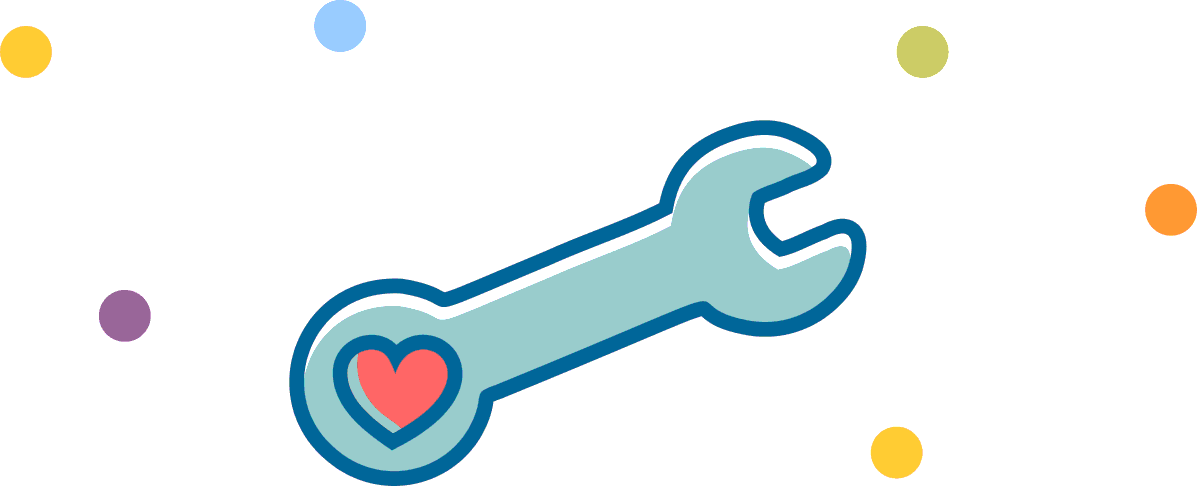
Welcome to Språkbyggarna!
Our ambition is to gather knowledge and experience about language development so that everyone interested can easily find everything from tips and inspiration to facts and deepening. Here you can read more about how the work is done and what Språkbyggarna stands for.
Språkbyggarna is a platform created and run by Hatten Publishing. Our goal is to offer a place that gathers different parts of the large area of language development.
Hatten Publishing has since the year 2000 produced and provided educational and fun materials to children, parents, educators, and other professionals. Our specialty is language development for children who need an extra boost and we work a lot with, for example, signs. Read more about us at hattenforlag.se
We who gather, write and design the content on Språkbyggarna have long experience of language development, both privately and within our profession. Språkbyggarna is the result of many years of networking, experiences and knowledge gathering, here gathered in one place. We work according to the motto that every single dot should have a language!
The editorial team consists of Ann-Charlotte
Ekensten, Elvira Ashby, and Anneli Tisell.
Do you have content that you want to share on Språkbyggarna? Do you have course activities? Have you written a book? Are you researching in the field or do you have thoughts and ideas on how to inspire others who want to build language?
Send an email to the editorial team!
Use the form below or info@hattenforlag.se
Our ambition to gather knowledge is based on the idea that we share with each other and constantly work to disseminate and make different opportunities to practically build language accessible.
Contact us
Email us at info@hattenforlag.se or use the form below.
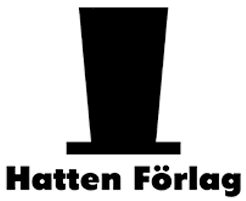 Our postal address:
Our postal address:
Hatten Publishing
Svärdvägen 27
182 33 Danderyd
Language development 2-4 years
Language development
2 to 4 years
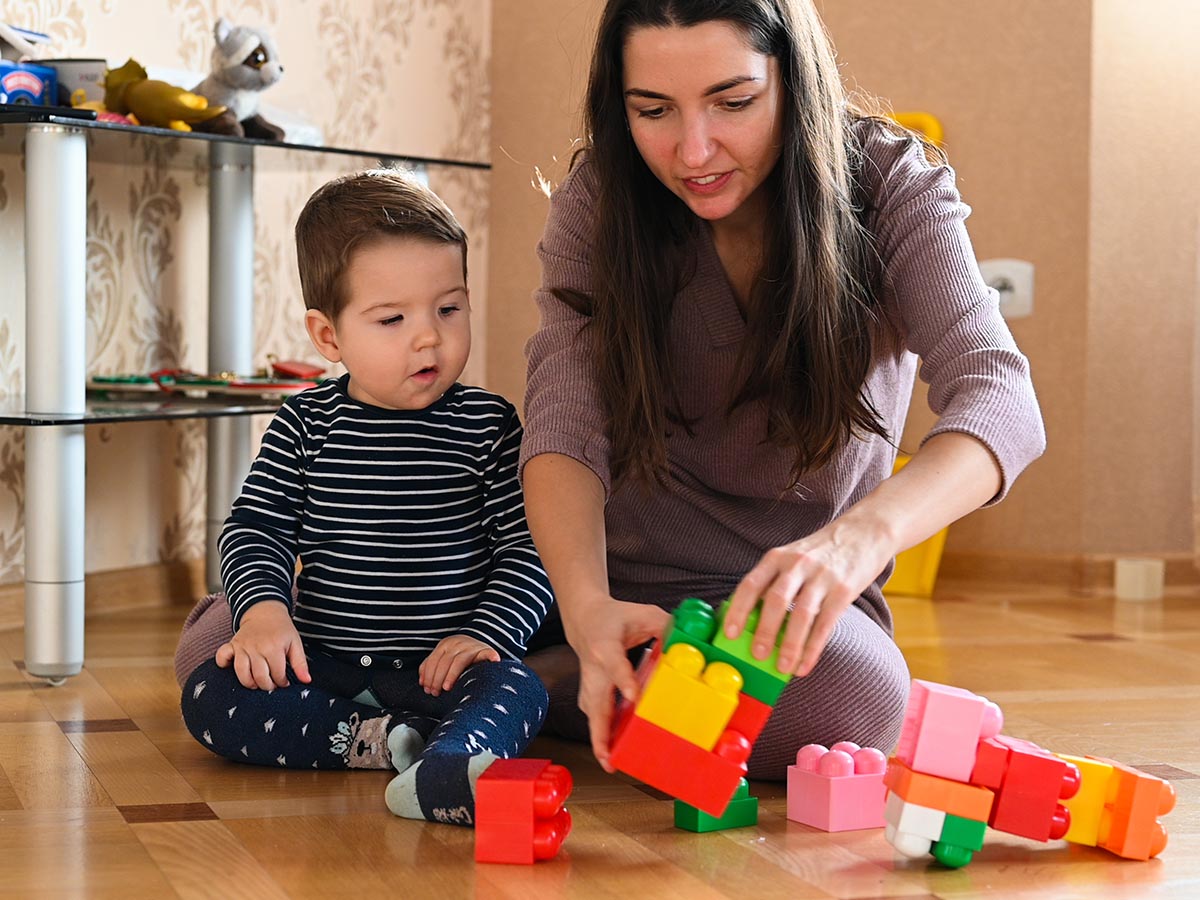
Language development2-3 years
At this age, a lot is happening! Vocabulary is growing, and it becomes easier to have small conversations with children about things they are interested in. They also start putting words together into short sentences. At first, two-word phrases like “look there” or “go car,” but gradually, the sentences become longer. Around the age of three, some children can form sentences with six to seven words.
Children also understand more of what we say. As they approach three years old, they can often follow slightly longer instructions, such as “Fetch the ball that’s under the table.”
Tips! Language development varies greatly among children at this age, and that’s perfectly normal. The important thing is that we, as adults around them, provide the support they need to develop at their own pace.
Typically, children at this age simplify the pronunciation of words, sometimes to the extent that it can be difficult for outsiders to recognize which word it is. “Bottle” can become “baba” and “open” can become “ma,” for example. Even as a parent, you may not understand everything the child says, but often, showing that you are genuinely listening and trying to understand goes a long way.
Tips! If the child becomes frustrated when you don’t understand what they’re saying, try to get them to express it in other ways. Encourage them to point or use body language.
“No” and “mine” are often important words as children want to express their desires. Eventually, they start using “I” to refer to themselves. They also begin to ask more and more questions, such as “what” and “who” questions. This is great because questions are how we learn!
As an adult, you can aim to stay one step ahead of the child and consistently use slightly longer sentences than they do. For example, instead of just stating the question word, use the whole sentence: “What are we going to do at the playground?” or “Who is ringing the doorbell?”
A great way to support children in developing their language is to make it a habit to pick up on what they say and expand on it a bit. For example, if the child says “no tetta,” you can say, “No, you don’t want to wash the teddy bear.” The child receives confirmation that you understood, and you become a good model for how they can build on their language.
Tips! Building language doesn’t have to be difficult. Engage in activities the child enjoys and label them with words. Read, recite rhymes, and sing together!
Language development3-4 years
Language continues to develop significantly at this age. Vocabulary expands, and the child understands and uses more complex sentences. Children also start incorporating more language into their play. They engage in imaginative and role-playing games, and they talk and narrate what’s happening during playtime.
The child’s pronunciation gradually becomes clearer, but simplifications still occur. Two consecutive consonants can be challenging, so “soap” may become “toap,” for example, and some speech sounds may be substituted with others. However, it is now much easier for outsiders to understand what the child is saying.
Tips!
If your child mispronounces words, there’s no need to correct them. However, you can always say the words as they should sound, serving as a model for how the child can say them next time.
Sometimes, children at this age have so much to say that they stumble over their words, and it may sound like they’re stuttering. In most cases, this phase passes on its own. However, it’s essential to give the child time to express themselves without interrupting or pressuring them when their words become jumbled.
Many children at this age enjoy talking and discussing. They can talk about things they’ve seen or done and ask many questions. This is, of course, excellent for language development. When we listen to children, respond to their questions, tell stories, and explain things, we contribute to the expansion of their vocabulary and their understanding of language.
Tips!
Read children’s books together and discuss what’s happening in the story. It’s a fantastic way to build vocabulary, among other things. If the child is just beginning to learn something specific, like colors, you can often find books that focus on that topic.
At this age, children also start learning more abstract words, such as words for shapes, sizes, and colors. Their understanding of simple concepts of time also tends to increase, so they grasp words like “after,” “first,” and “tomorrow,” even if they can’t determine the exact duration, such as an hour. Children begin to count up to three, and sometimes even higher.
Language Development 0-2 Years
Language development
0 to 2 years

Language Development0-4 months
Already, the newborn baby can interact with us by using their voice, eye contact, and body language. Crying indicates that something is wrong, and when babies look at us, they may want to make contact. We should be attentive and interpret the signals from the children.
At around two months of age, babies often start making more sounds, such as simple vowel sounds like “aaa” and “ooo”. As they grow, they begin to try different sounds and imitate what they hear. In this way, children collect building blocks they need to start speaking. Many speech sounds and the melody of language are learned early on.
Tips!
Listen and observe carefully to how the child sounds and moves. This way, you can understand how the child is feeling and what they want.
Children need to hear a lot of spoken language and often enjoy listening when we talk to them. Speak cheerfully and softly, and smile at the same time. Eventually, children may start smiling in response.
If you pay attention, you can also see how the child responds in other ways, such as moving their body or using different sounds when you talk and play together. It’s the beginning of a conversation, and both enjoyable and developmental for the children.
Tips!
Talk to the child and tell them about what you see and experience. Even if the child doesn’t understand everything, it is still interesting and developmental. The child is also encouraged to try different sounds themselves.
Language Development4-8 months
The child tries more and more sounds, and their babbling becomes increasingly varied. Often, the first consonants appear at the beginning of this period, and towards the end, children usually start with syllable babbling, like “da-da-da.” The child also experiments with different vocal tones and volumes.
The child listens more attentively when you speak, and eventually, they begin to understand more and more common recurring words. The child may start to react to their name or words like “no,” for example. However, the child also perceives differences in the tone of your voice, whether you sound angry or happy, for instance.
Children at this age also often start to notice more about what others are looking at and doing. If you look at something, the child may, for example, turn around and look in the same direction.
Tips!
Take the opportunity to verbalize what you and the child are looking at. Also, listen to the child and respond when they babble or try to communicate! It’s both exciting and developmental for the child, and when you take turns – listening and talking – the child practices the foundation of regular conversations, turn-taking.
Children’s own communication, through body language, facial expressions, and sounds, becomes gradually clearer. They use their voice more variably and can often, in their own way, indicate if they are happy, hungry, or tired. However, children still rely on us to interpret and try to understand the meaning behind their expressions.
Tips!
Feel free to be overtly clear when you talk to your child. Use facial expressions, gestures, or signs, and repeat words. Overt clarity makes it easier for the child to understand, and you also show the child how they can use their body to make themselves understood.
Language Development8-12 months
Now, children often begin to use more gestures to communicate, such as pointing, showing, and waving. However, the exact timing of when this occurs can vary. Some children start pointing at 8 months old, while others do so at 16 months. Eventually, many children combine gestures and sounds to make themselves understood, so they may both point and make sounds at the same time.
Children understand many words before they start speaking themselves, and they can demonstrate this by, for example, turning towards familiar objects when you say their name. Eventually, the child may also start following simple commands, such as taking or patting something.
Towards the end of this period, the first real words typically emerge, such as “mommy,” “daddy,” or “look,” for example.
It’s not always easy to distinguish between babbling and real words. Even if you’re not sure, you can interpret what the child says as words and confirm and repeat that word, thus supporting the child’s development. By responding and showing interest, you encourage the child to speak more and try again.
Tips!
Repeat what the child says and respond to the child’s sounds, movements, and gazes as if they mean more than they do. For example, if the child is interested in a lamp and says “ma,” you can say, “Yes, lamp! What a nice lamp.”
At this age, it also becomes easier to look at interesting things together. It’s important for the child to understand how everything works and to learn more words along the way. If you talk and use gestures while looking at something, the child also gets the opportunity to imitate both movements and sounds.
It’s still not always easy to understand what the child means, but your efforts to understand contribute to the development of your communication. In many situations throughout the day, the child can practice communicating and showing what they want, such as at the dinner table or during playtime.
Tips!
Read, point, and look at simple books together. Label what things in the book are called and perhaps how they sound. Encourage the child to join in and imitate sounds or make movements and gestures, and point to things.
Language Development1-1.5 years
Around one year old, children usually start saying their first words, but the exact timing can vary greatly. Some children say their first words at 10 months old, while others may be closer to 18 months.
Sometimes it can also be difficult to determine whether something is a real word or just babbling, but even if you’re unsure, it’s always good to try to interpret and respond to it as if it were a word. It supports the child’s development.
The first words are often names for things that are significant to the child, such as “mommy” and “daddy.” In the beginning, words can mean more or less than what they do for adults. “Car” can be used for all kinds of vehicles, while “teddy bear” is only used for a specific teddy bear. Many children have their own words for different things, and word pronunciations can be greatly simplified, such as “bottle” becoming “baba.”
A single word can also represent a whole sentence. For example, “den” can mean “give me that.”
Tips!
Make it a habit to pick up on what the child is saying and expand on it a bit. If the child says “mu,” you can say, “Yes, moo, there’s a cow. What a big cow!” This way, you continuously support the child in building on their language.
Even after the first words have emerged, children still communicate a lot through gestures and pointing. The child can become frustrated and angry when they can’t make themselves understood, but by listening and showing that you’re trying to understand, and using all the clues to figure out what the child wants, communication develops. When you think you’ve figured out what the child means, put it into words, as you serve as a model for how the child can develop their language.
Tips!
Make it a habit to tell your child what you’re doing and what you’re going to do throughout the day: “Now that you’ve had a bath, we’ll put on a diaper.” and “We’ll take the green pants.” Let the child participate in everyday activities as well, such as fetching things.
Language Development1.5-2 years
Around one and a half years old, there is often a period where vocabulary grows rapidly – sometimes referred to as a “vocabulary explosion.” The exact timing of this period and how quickly the vocabulary grows varies from child to child. It means that a child at around two years old can say anywhere from about fifty to several hundred words.
At two years old, many children also start combining words into short sentences, usually two-word phrases like “look there” or “doggy sleep.” It starts to become a bit easier for the child to express what they want and need. The word “no” can become particularly interesting and important, as well as words like “mine” and “my.”
The child understands more and soon catches on to most of what you talk about in everyday life. They may start fetching things you ask for, such as a toy, or point out body parts if you ask, for example, “Where is the mouth?”
Tips!
By actively listening to and talking a lot with the child, you not only stimulate their language but also their overall development. For example, you can tell them about what you see that the child is interested in and everything you experience together. Make use of children’s books, songs, and rhymes, and encourage the child to participate by filling in with words, gestures, and sounds.
Language development 4-6 years
Language development
4 to 6 years
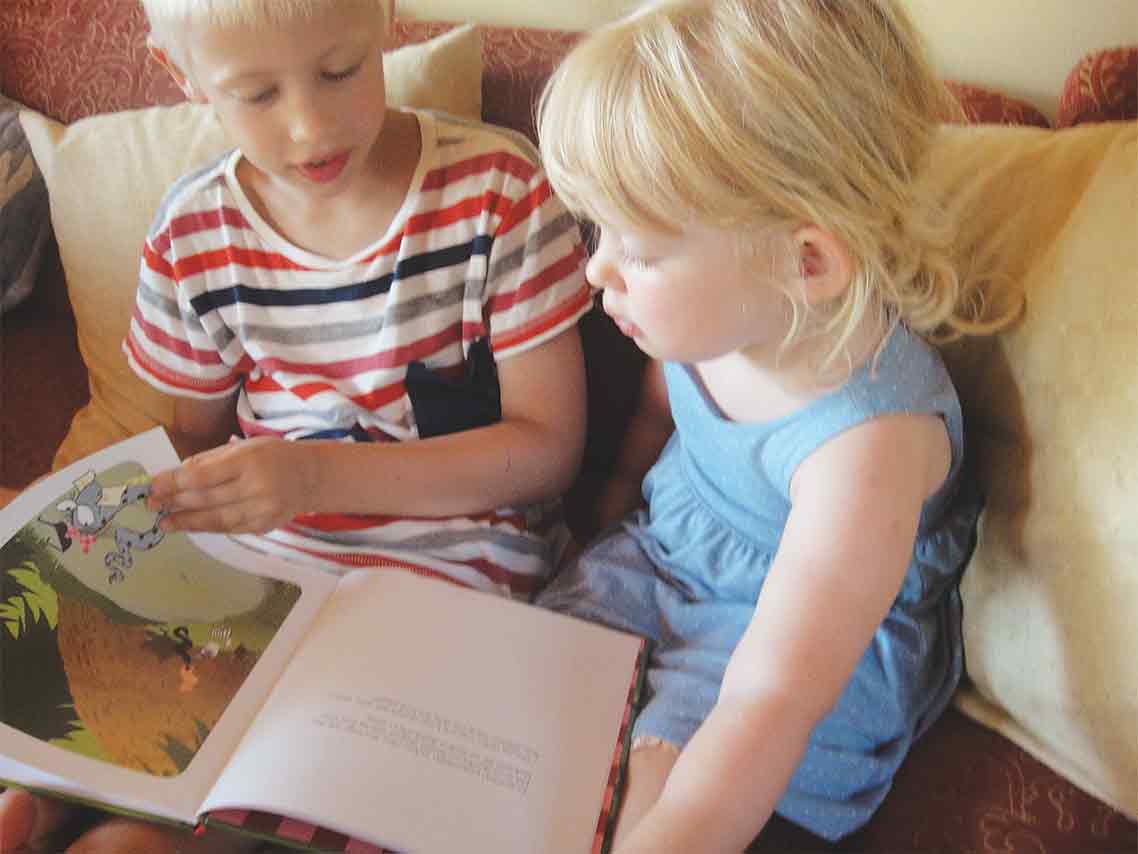
Language development4-5 years
At this age, children’s language often becomes more and more adult-like, and finer details start to fall into place. They can tell more complex stories, use longer sentences, and often conjugate words correctly. Some irregular verb forms may still be challenging. For example, children may say “goed” instead of “went”. It is also common for children to struggle with the pronunciation of certain speech sounds. The sounds of “r” and “sh”, for instance, often don’t fully develop until later in school age.
Tips!
A tip when a child says something that is not quite right, like “he goed to the slide”, is to provide the correct version and expand upon it. For example, say, “Yes, he went over to the slide. What is he doing over there?”
Children’s interest in numbers and letters usually emerges, and if a child is struggling with the pronunciation of certain speech sounds, we can often incorporate it into play with sounds. Sometimes children may not fully grasp the distinction between “k” and “t” sounds, for example, and it becomes clearer when looking at letters together and trying to come up with words that start with either sound.
Children’s understanding and use of more complex concepts also tend to develop. It can involve comparing things, identifying what is “bigger” or “smaller”, “similar” or “different”.
Tips!
Think of yourself as feeding your child with new words. Abstract concepts are often easier for children to understand if we try to make them as concrete as possible. We can show, draw, or conduct small experiments together, such as having children feel something “heavy” and something “light” while discussing the words.
Children at this age also start to have a little easier time empathizing with how others feel and think, and they understand that not everyone thinks exactly like they do. This can make cooperation and compromise easier, although it can still be challenging for children to not get what they want, and our empathy is something that can develop throughout life.
Tips!
One tip is to take the time to put feelings into words, both for children and others. If there has been a conflict over something, you can talk through what happened during a calm moment and maybe brainstorm together what to do differently if the situation arises again.
Language development5-6 years
Now it’s almost time for school! Children’s thinking develops, and they become better at drawing conclusions and understanding contexts. They continue to learn a lot through play but are also usually able to sit still and concentrate for a while on different tasks.
Something that is beneficial for later reading and writing development is to play with language together. We can rhyme and recite nursery rhymes, talk about how words sound, and listen for the sounds in words. This builds up linguistic awareness, which is the ability to look at language from a slightly external perspective.
Tips!
Read ABC books and take the opportunity to introduce how the letter sounds. The letters have both sounds and names. “M” is called “em” but sounds like “mmm,” and it’s actually the sound “mmm” that the child needs to start blending words together.
Some individual speech sounds may still be challenging for the child to pronounce. For example, around 20% of five-year-olds still struggle with the “r” sound. The child may also make mistakes with some uncommon endings, but generally, their sentences are grammatically correct.
Children often begin to learn more things by heart and may be interested in facts about different things. Take advantage of their curiosity, find out more information, explain at the child’s level, and seize the opportunity to expand their vocabulary.
In the 6-year-old age range, a child’s vocabulary can contain between 10,000 and 15,000 words, and the more we read and talk with the child, the more words they will learn.
Tips!
Pick up on unusual and complex words, for example, when reading books, and take the opportunity to explain and discuss their meanings.
Explaining and telling about more complex things can still be challenging for the child, but we can facilitate it by listening attentively, giving the child time, and assisting by asking supportive questions. For example, “Where did this happen?” or “What happened next?”
Creating our own stories together can also be a fun way to support the child’s development of storytelling.
At this age, friends are often important, and children may begin to compare themselves more with others. It can become more challenging for them not to know things, and it is good for us to support them in that. We can talk about how everyone has things they find difficult and encourage children to try again.
Tips!
Continue talking about feelings with the child, both their own and others’. Being able to put words to feelings facilitates interaction with friends and others.

